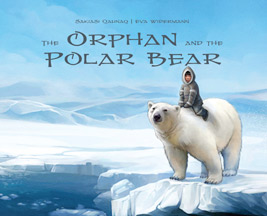The Orphan and the Polar Bear by S. Qaunaq
DOI:
https://doi.org/10.20361/G2S88KAbstract
Qaunaq, Sakiasi. The Orphan and the Polar Bear. Iqaluit: Inhabit Media, Inc., 2011. Print.
One of the common themes in Inuit stories is that of the orphan child alone on the land. In this version, told by Arctic Bay elder Sakiasi Qalinaq, who learned his stories from his grandmother, the orphan is abandoned by hunters from his village and adopted by a village of polar bears. The bears teach him to hunt and survive on the land and, when he is grown, return him to his people. The image on the cover of the book showing the child riding the polar bear is an iconic one. This mythological relationship between child and polar bear is also found in non-Inuit literature, most notably in Philip Pullman’s The Golden Compass.
In the bears’ village the orphan is trained to hunt and survive on the land. The bears also teach him their traditional wisdom. For example, when one of the bears wants to go “push down” some humans because they “look so silly standing on their skinny legs”, a wiser elder bear says, “Never talk that way…don’t make humans our enemy. Stay clear of them and their camps.”
The book is primarily a picture-book. Unlike many of the other books of Inuit legends published by Inhabit Media, the pictures are not scary. Rather they are quite beautiful. The extra width of the landscape format gives artist, Eva Widermann, the opportunity to spread her illustrations across two pages reflecting the wide expanses of the Arctic. Text usually takes up one corner or a few lines of a page. Widermann’s images are realistic. However, because this story is from a time when animals could shape-shift into human form, she sometimes gives the bears human postures and gestures. For example, in the image on page 15, the polar bear is standing with a harpoon grasped in its front paws, handing it to the orphan. Bears are also shown in their human form in three images. In the image on page 20, depicting the inside of an igloo in the bears’ village, a woman with human form is tending the fire.
Overall this is a lovely rendition of the story. While designed for an elementary school audience, anyone with an interest in traditional Arctic tales will enjoy it. Recommended for elementary schools and public libraries.
Recommendation: 4 out of 4 stars
Reviewer: Sandy Campbell
Sandy is a Health Sciences Librarian at the University of Alberta, who has written hundreds of book reviews across many disciplines. Sandy thinks that sharing books with children is one of the greatest gifts anyone can give.

Published
How to Cite
Issue
Section
License
Authors who publish with this journal agree to the following terms:
- Authors retain copyright and grant the journal right of first publication with the work simultaneously licensed under a Creative Commons Attribution License that allows others to share the work with an acknowledgement of the work's authorship and initial publication in this journal.
- Authors are able to enter into separate, additional contractual arrangements for the non-exclusive distribution of the journal's published version of the work (e.g., post it to an institutional repository or publish it in a book), with an acknowledgement of its initial publication in this journal.
- Authors are permitted and encouraged to post their work online (e.g., in institutional repositories or on their website) prior to and during the submission process, as it can lead to productive exchanges, as well as earlier and greater citation of published work (See The Effect of Open Access).






